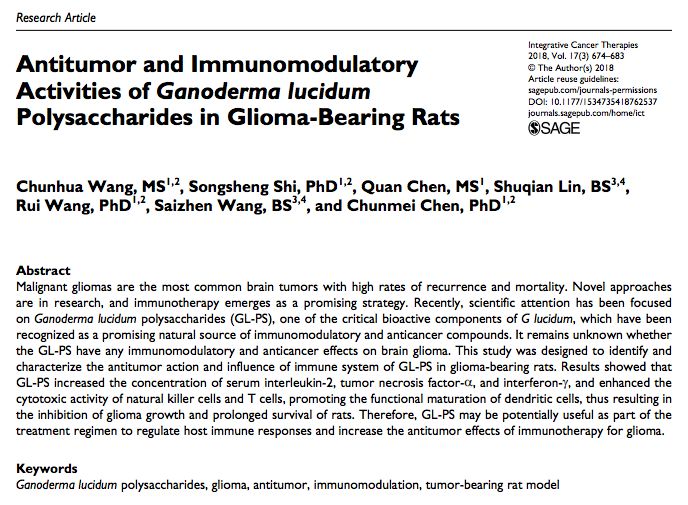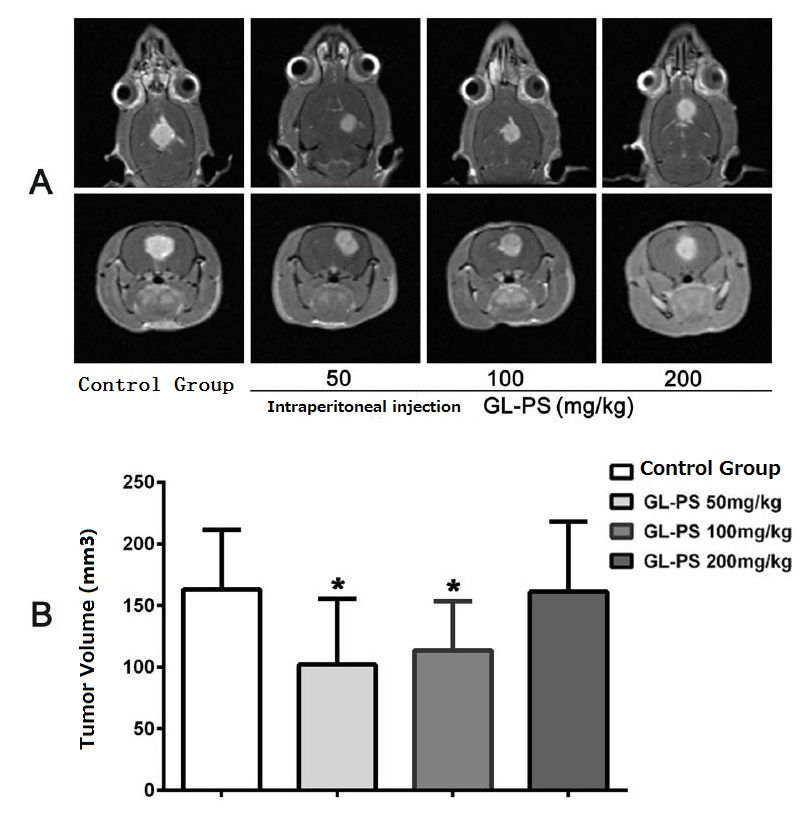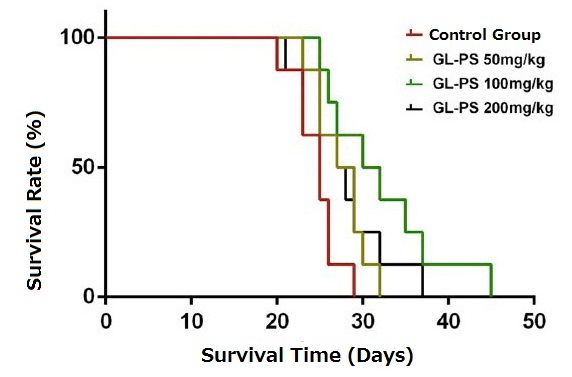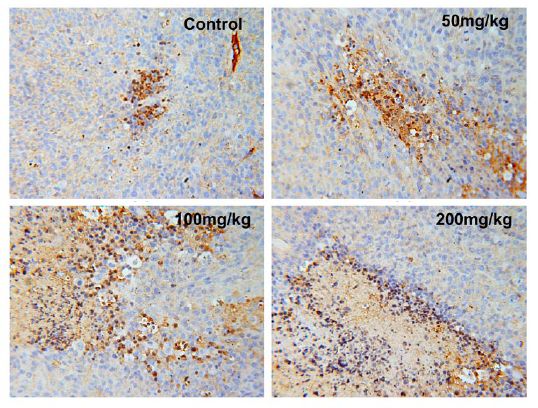9月 2018 / 福建医科大学連合病院, etc. / 統合癌療法
文/呉廷耀

食べますマンネンタケ 脳腫瘍患者の症状を緩和するのに役立ちます? これはおそらく、国際ジャーナルの最初のレポートです。マンネンタケ 動物実験を通じてin vivoで脳腫瘍を阻害する– それは私たちにいくつかの考えをもたらすことができます.
神経膠腫は一般的なタイプの脳腫瘍です. それは、神経細胞を包むグリア細胞の異常な増殖によって引き起こされます. ゆっくりと成長する良性腫瘍かもしれません (それが頭痛やその他の不快な症状を引き起こすかどうかは、腫瘍の位置とサイズに依存します), または、急速に成長する悪性腫瘍かもしれません.
悪性神経膠腫は栄養の機能を失いました, 神経細胞のサポートと保護. 速く成長するだけではありません, しかし、それはまた短時間で広がる可能性があります. This type of malignant glioma, which grows and spreads quickly, is also called glioblastoma. It is one of the most common and deadly brain tumors in humans. Even if patients receive aggressive treatment immediately after diagnosis, their average remaining life span is only 14 数ヶ月. のみ 5% of patients survive for more than five years.
Therefore, how to effectively strengthen the anti-cancer ability of the patient’s own immune system has become the main field of exploration in the treatment of glioblastoma in the medical field in recent years. It is an accepted fact thatマンネンタケ 多糖類 (GL-PS) can regulate immunity, but because the blood-brain barrier between the brain and blood vessels can selectively prevent certain substances in the blood from entering the brain cells, whetherマンネンタケ 多糖類は、脳の膠芽腫を阻害する可能性があることをさらに確認する必要があります.
Fujian Medical University Union Hospitalが共同で公開したレポート, 福建省脳神経外科研究所, 9月に福建農業および林業大学 2018 「統合癌療法」では、結実体から分離された多糖類が確認されたことが確認されましたマンネンタケ (GL-PS) 膠芽腫の成長を阻害し、腫瘍を含むラットの生存期間を延長することができます. その作用メカニズムは免疫の改善に密接に関連しています.
実験結果 1: 腫瘍は比較的小さいです
実験で使用されるGL-PSは、分子量がほぼの高分子多糖類です 585,000 のタンパク質含有量 6.49%. 研究者は最初にラットの脳に膠腫細胞を接種した, そして、の毎日の投与で腹腔内注射によってラットにGL-PSを投与しました 50, 100 または 200 mg/kg).
2週間の治療の後, 実験ラットの脳腫瘍のサイズをMRIによって検査しました (図1a). 結果は、がん細胞を接種したがGL-PSが与えられていない対照群ラットと比較したことを示した, 投与されたラットの腫瘍サイズ 50 and 100 mg/kg GL-PSは平均で約3分の1減少しました (図1b).

形 1 脳腫瘍に対するGL-PSの阻害効果 (神経膠腫)
実験結果 2: 生存率の長期
MRIが完了した後, すべての実験ラットは死ぬまで供給され続けました. 結果は、最も長く生きているのは与えられたラットであることを発見しました 100 mg/kg gl-ps. 平均生存時間はそうでした 32 日, これはより3分の1長いものでした 24 コントロールグループの日. ネズミの1つは生きていました 45 日. As for the other two groups of GL-PS rats, the average survival time is about 27 日, which is not much different from that of the control group.

形 2 The effect of GL-PS on the life span of rats with brain tumors (神経膠腫)
実験結果 3: Improving the anti-tumor ability of the immune system
The researchers further explored the effects ofマンネンタケ polysaccharides on the immune function of rats with brain tumors and found that the cytotoxic T cells (形 3) in the brain tumors and lymphocytes (including T Cells and B cells) in the spleen of the rats injected withマンネンタケ polysaccharides were significantly increased in the blood. The concentration of anti-tumor cytokines, such as IL-2 (interleukin-2), TNF-α (tumour necrosis factor α) and INF-γ (interferon gamma), secreted by immune cells was also higher than that of the control group.
加えて, 研究者はまた、in vitro実験を通じて確認しましたマンネンタケ 多糖類は、神経膠腫細胞に対する天然キラー細胞の致死性を高めるだけでなく、樹状細胞を促進することもできます (外国の敵を特定し、免疫系の免疫応答を開始する原因となる細胞) がん細胞と戦うために免疫系の活性化をスピードアップする, また、細胞毒性T細胞の生成にも貢献しています (がん細胞を1対1で殺すことができます).

形 3 脳腫瘍における細胞毒性T細胞の数に対するGL-PSの効果 (神経膠腫)
[説明] これはラット脳腫瘍の組織セクションです, 茶色の部分は細胞毒性T細胞です. コントロールとは、コントロールグループを指します, 他の3つのグループはGL-PSグループです. 指定されたデータはの用量ですマンネンタケ 腫瘍を含むラットの腹腔内腔に注入された多糖類.
の機会を見るマンネンタケ 脳腫瘍と戦うための多糖
上記の研究結果は、適切な量の量がマンネンタケ 多糖類は脳腫瘍と戦うのに役立ちます. 腹腔に注入された多糖類は肝臓の門脈から吸収され、肝臓によって代謝され、血液循環に入って血液中の免疫細胞との相互作用に入るため. Therefore, ラット脳腫瘍の成長を制御し、生存期間を延長できる理由は、免疫応答の刺激と免疫機能の改善に関連する必要があります。マンネンタケ 多糖類.
明らかに, 生理学的構造の血液脳関門は、の抑制効果を保護しませんマンネンタケ脳腫瘍上の多糖. 実験結果は、の投与量もマンネンタケ 多糖類はそれほど良くありません, しかし、あまりにも効果がほとんどないようです. 「適切な量」はいくらですか. 違う可能性がありますマンネンタケ 多糖類には独自の定義があります, そして、経口投与の効果が腹腔内注射の効果と同等であるかどうかは、さらなる研究によって確認される必要があります.
しかし, これらの結果は、少なくともからの多糖の可能性を明らかにしましたG明瞭な陰皮 脳腫瘍の成長を阻害し、生存率を延長します, 限られた治療の現在の状況では試してみる価値があるかもしれません.
[ソース] お金c, 他. 神経膠腫を含むラットにおけるganoderma lucidum polysaccharidesの抗腫瘍および免疫調節活性. 統合がんther. 2018 9月;17(3):674-683.
[参考文献] トニー・ダンブロシオ. 神経膠腫vs. 膠芽腫: 治療の違いを理解する. ニュージャージーの脳神経外科医. 2017 8月 4.
終わり
著者について/Mさん. 呉廷耀
ウー・ティンヤオ氏は、以来、霊芝に関する直接の情報を報告し続けている。 1999. 彼女はの著者です霊芝による治癒 (4月に人民医学出版社に出版 2017).
★この記事は著者の独占的な許可を得て掲載されています.
★上記作品は転載禁止です, 著者の許可なく抜粋または他の方法で使用される.
★上記記載事項に違反した場合, 著者は関連する法的責任を追及します.
★この記事の原文はWu Tingyaoが中国語で執筆し、Alfred Liuが英語に翻訳しました。. 翻訳に齟齬があった場合 (英語) そしてオリジナル (中国語), 本来の中国人が勝つだろう. 読者に質問がある場合, 原作者に連絡してください, MS. 呉廷耀.



